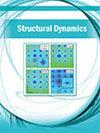光激发无机钙钛矿中的定域空穴和离域电子:用皮秒x射线吸收光谱观察每个原子行为体
IF 2.3
2区 物理与天体物理
Q3 CHEMISTRY, PHYSICAL
引用次数: 62
摘要
本文报道了利用80ps时间分辨率的时间分辨x射线吸收光谱对光激发无机CsPbBr3和CsPb(ClBr)3钙钛矿纳米晶体在甲苯溶液中的载流子命运的元素选择性研究。探测到Br k边、Pb l3边和Cs l2边,我们发现价带中的空穴定位在Br原子上,形成小极化子,而电子则在导带中出现离域。在Cs l2边缘没有观察到电子或结构变化的特征。Br和Pb边缘的结果表明存在弱局域激子,而Cs边缘没有特征表明Cs+阳离子在电荷输运中没有作用,至少超过80 ps。这是钙钛矿的第一个时间分辨元素特异性研究,有助于理解这些材料中相当适度的载流子迁移率。本文章由计算机程序翻译,如有差异,请以英文原文为准。
Localized holes and delocalized electrons in photoexcited inorganic perovskites: Watching each atomic actor by picosecond X-ray absorption spectroscopy
We report on an element-selective study of the fate of charge carriers in photoexcited inorganic CsPbBr3 and CsPb(ClBr)3 perovskite nanocrystals in toluene solutions using time-resolved X-ray absorption spectroscopy with 80 ps time resolution. Probing the Br K-edge, the Pb L3-edge, and the Cs L2-edge, we find that holes in the valence band are localized at Br atoms, forming small polarons, while electrons appear as delocalized in the conduction band. No signature of either electronic or structural changes is observed at the Cs L2-edge. The results at the Br and Pb edges suggest the existence of a weakly localized exciton, while the absence of signatures at the Cs edge indicates that the Cs+ cation plays no role in the charge transport, at least beyond 80 ps. This first, time-resolved element-specific study of perovskites helps understand the rather modest charge carrier mobilities in these materials.
求助全文
通过发布文献求助,成功后即可免费获取论文全文。
去求助
来源期刊

Structural Dynamics-Us
CHEMISTRY, PHYSICALPHYSICS, ATOMIC, MOLECU-PHYSICS, ATOMIC, MOLECULAR & CHEMICAL
CiteScore
5.50
自引率
3.60%
发文量
24
审稿时长
16 weeks
期刊介绍:
Structural Dynamics focuses on the recent developments in experimental and theoretical methods and techniques that allow a visualization of the electronic and geometric structural changes in real time of chemical, biological, and condensed-matter systems. The community of scientists and engineers working on structural dynamics in such diverse systems often use similar instrumentation and methods.
The journal welcomes articles dealing with fundamental problems of electronic and structural dynamics that are tackled by new methods, such as:
Time-resolved X-ray and electron diffraction and scattering,
Coherent diffractive imaging,
Time-resolved X-ray spectroscopies (absorption, emission, resonant inelastic scattering, etc.),
Time-resolved electron energy loss spectroscopy (EELS) and electron microscopy,
Time-resolved photoelectron spectroscopies (UPS, XPS, ARPES, etc.),
Multidimensional spectroscopies in the infrared, the visible and the ultraviolet,
Nonlinear spectroscopies in the VUV, the soft and the hard X-ray domains,
Theory and computational methods and algorithms for the analysis and description of structuraldynamics and their associated experimental signals.
These new methods are enabled by new instrumentation, such as:
X-ray free electron lasers, which provide flux, coherence, and time resolution,
New sources of ultrashort electron pulses,
New sources of ultrashort vacuum ultraviolet (VUV) to hard X-ray pulses, such as high-harmonic generation (HHG) sources or plasma-based sources,
New sources of ultrashort infrared and terahertz (THz) radiation,
New detectors for X-rays and electrons,
New sample handling and delivery schemes,
New computational capabilities.
 求助内容:
求助内容: 应助结果提醒方式:
应助结果提醒方式:


